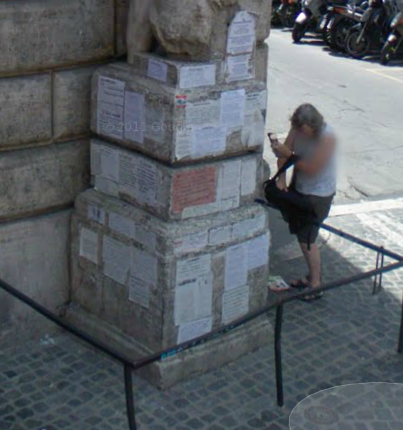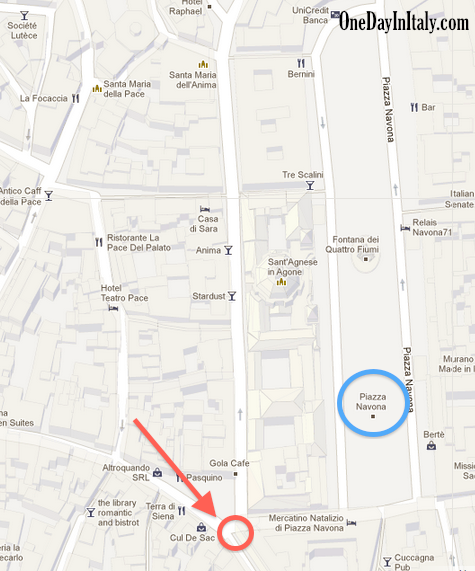Before I left for Rome I bought a stack of cards called “Rome Walks”. It’s a series of 4X6 cards with a map on one side and a short walking tour with just enough interesting details on the other. Each morning I’d grab a handful of cards for whatever part of the city I was going to be in that day and head out.
I hate tour books. They always tell you too much and most of it is boring. ”Rome Walks” tells you just enough, and a lot of it is interesting tidbits – like Pasquino here:

Following the map on the Rome Walks card around the south corner from Piazza Navona, I probably would’ve walked right by this statue even with the crowd of people around it if not for my note on flip side of the card. It just looks like a thoroughly beaten and magled statue with graffiti and local flyers plastered on it. If you actually walk up to it and read the flyers, though, you’ll see its not someone trying to find their lost dog or offering babysitting services. It’s a whole lot of people expressing their disdain and anger with the government, the church, their neighbor – anyone or anything, really.

(photo courtesy Google StreetView – I don’t know how they always seem to miss the crowds!)
I’ve heard several different versions of how the tradition of posting inflammatory remarks on this statue came to be, but this is the story I heard while in Rome, in two parts:
Part 1: In 1501, Cardinal Oliviero Carafa placed this much-damaged statue at the corner of the building in which he lived (which has since been demolished & rebuilt). On St. Mark’s Day he dressed it up in a toga, which started the tradition of putting things on this particular statue.
Part 2: Pasquino was a tailer in Rome during the Renaissance who posted harsh criticisms of the Popes, the church and any political faction he didn’t like around the city, including on this statue. Soon, all talk of that kind began to be attributed to him, coining the Italian term “pasquinade” (according to TheFreeDictionary.com: “n. A satire or lampoon, especially one that ridicules a specific person, traditionally written and posted in a public place”). Now, this is the only remaining in the city statue where citizens of Rome post – anonymously – their discontent.
Put those together as you will, its a cool piece of history / folklore that I probably wouldn’t've otherwise known. At the time I didn’t know any Italian to speak of so I didn’t bother going up and taking pictures of any of the postings on the pedestal and as I said, the crowds were milling around the base, making shouldering your way up to it difficult, but if you’d like to find Piazza di Pasquino while you’re in Rome, here’s a map:

And if you’re interested in the “Rome Walks” cards, you can buy them at Amazon.
Comments
comments










Leave a Reply